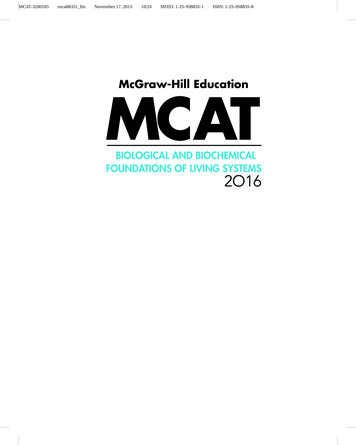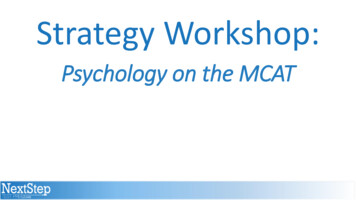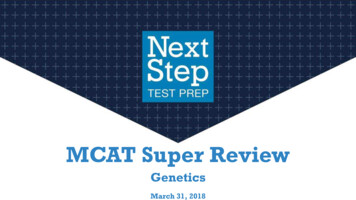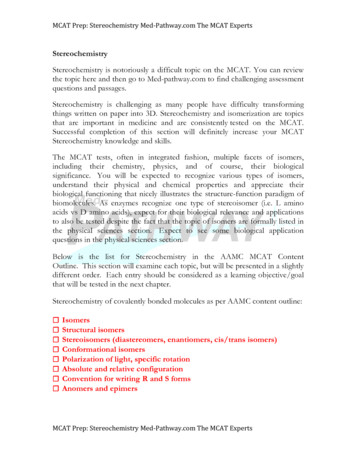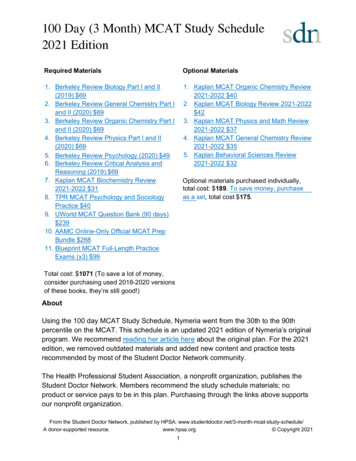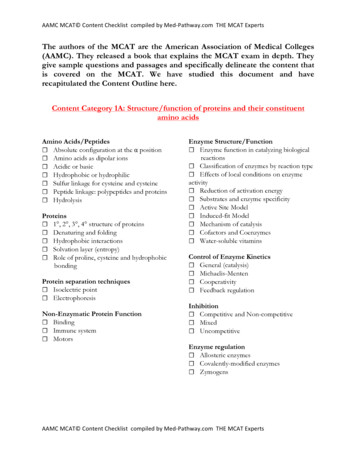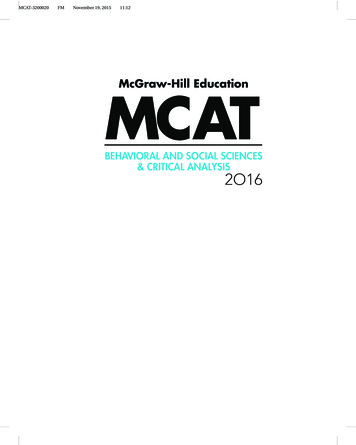
Transcription
MCAT-3200020FMNovember 19, 201511:12McGraw-Hill EducationMCATBEHAVIORAL AND SOCIAL SCIENCES& CRITICAL ANALYSIS2O16
MCAT-3200020FMNovember 19, 201511:12McGraw-Hill EducationMCATTest Preparation Series Biomolecules Molecules, Cells,and Organs Systems of Tissuesand Organs Physical Foundations of Biological Systems Perception and Practice Test 1Response Answers andExplanations Practice Test 2Answers andChemical Foundations Behaviorof Biological Systems Self and OthersSocial Structure Social Strata Critical Analysis andReasoning Skills Explanations
MCAT-3200020FMNovember 19, 201511:12McGraw-Hill EducationMCATBEHAVIORAL AND SOCIAL SCIENCES& CRITICAL ANALYSIS2O16George J. Hademenos, PhDCandice McCloskey Campbell, PhDShaun Murphree, PhDAmy B. Wachholtz, PhDJennifer M. Warner, PhDKathy A. Zahler, MSThomas A. Evangelist, MAContributorNew York Chicago San Francisco Athens London MadridMexico City Milan New Delhi Singapore Sydney Toronto
MCAT-3200020FMNovember 19, 201511:12Copyright 2016 by McGraw-Hill Education. All rights reserved. Printed in theUnited States of America. Except as permitted under the United States Copyright Actof 1976, no part of this publication may be reproduced or distributed in any form orby any means, or stored in a database or retrieval system, without the prior writtenpermission of the publisher.1 2 3 4 5 6 7 8 9 10 CUS/CUS 1 2 1 0 9 8 7 6 5ISBNMHID978-1-25-958839-61-25-958839-4e-ISBN 978-1-25-958840-2e-MHID1-25-958840-8MCAT is a registered trademark of the Association of American Medical Colleges,which was not involved in the production of, and does not endorse, this product.Amy B. Wachholtz, PhD, would like to thank Christopher Ayala, MA, for assistancewith fact checking and editing the behavioral and social sciences material in thisvolume.McGraw-Hill Education products are available at special quantity discounts to use aspremiums and sales promotions or for use in corporate training programs. To contacta representative, please visit the Contact Us pages at www.mhprofessional.com.This book is printed on acid-free paper.
MCAT-3200020FMNovember 19, 201511:12ContentsAbout the Authors . . . . . . . . . . . . . . . . . . . . . . . . . . . . . . . . . . . . . . . . . . . . . . . . . . . . . . . . . . . ixHow to Use the McGraw-Hill Education MCAT Preparation Series. . . . . . . . . . . . . . xiIntroducing the MCAT . . . . . . . . . . . . . . . . . . . . . . . . . . . . . . . . . . . . . . . . . . . . . . . . . . . . . . . xvMCAT Basics The Computerized Test Format Where and When to Take theMCAT How to Register for the MCAT Taking the MCAT More Than Once Your MCAT Scores How Medical Schools Use MCAT Scores ReportingScores to Medical Schools For Further Information The Format of theTest What Is Tested in the Science Sections What Is Tested in CriticalAnalysis and Reasoning Skills General Test-Taking StrategiesPART 1 PSYCHOLOGICAL, SOCIAL, ANDBIOLOGICAL FOUNDATIONSOF BEHAVIORUnit I Perception and ResponseChapter 1Sensing the Environment . . . . . . . . . . . . . . . . . . . . . . . . . . . . . . . . . . . . . . 5Sensory Processing Vision Hearing Somatization: Tactile Sensation Taste Smell PerceptionChapter 2Making Sense of the Environment . . . . . . . . . . . . . . . . . . . . . . . . . . . . 23Attention Cognition Culture, Environment, and Biology in CognitiveDevelopment Problem Solving Decision Making Intelligence Nature,Nurture, and Intelligence Measuring Intelligence Memory LanguageChapter 3Responding to the World . . . . . . . . . . . . . . . . . . . . . . . . . . . . . . . . . . . . . . 39Emotion StressUnit I MINITEST45v
MCAT-3200020FMNovember 19, 201511:12viContentsUnit II BehaviorChapter 4Individual Influences on Behavior . . . . . . . . . . . . . . . . . . . . . . . . . . . . 61The Nervous System The Endocrine System Behavioral Genetics Personality Psychological Disorders Motivation Sleep AttitudesChapter 5Social Processes That Influence Human Behavior . . . . . . . . . . . . 85How Groups Affect Individuals Culture SocializationChapter 6Attitude and Behavior Change . . . . . . . . . . . . . . . . . . . . . . . . . . . . . . . . 91Associative Learning Observational Learning Theories of Attitudesand Behavior ChangeUnit II MINITEST101Unit III Self and OthersChapter 7Self-Identity . . . . . . . . . . . . . . . . . . . . . . . . . . . . . . . . . . . . . . . . . . . . . . . . . 115Self-Concept and Self-Esteem Identity Formation Early Attachmentand SocializationChapter 8Social Thinking . . . . . . . . . . . . . . . . . . . . . . . . . . . . . . . . . . . . . . . . . . . . . . 121Attribution Theory Prejudice, Bias, and Discrimination Stereotypesand EthnocentrismChapter 9Social Interactions . . . . . . . . . . . . . . . . . . . . . . . . . . . . . . . . . . . . . . . . . . 127Expressing and Detecting Emotion Impression Management RomanticAttraction Aggression/Altruism Social Behavior Among StrangersUnit III MINITEST135Unit IV Social StructureChapter 10Understanding Social Structure . . . . . . . . . . . . . . . . . . . . . . . . . . . . 151Social Structure and Development Social Institutions CultureChapter 11Demographic Characteristics and Processes . . . . . . . . . . . . . . . 157Elements of Social Interactions The Demographic Structure of SocietyUnit IV MINITEST163
MCAT-3200020FMNovember 19, 201511:12viiUnit V Social StrataChapter 12ContentsSocial Inequality . . . . . . . . . . . . . . . . . . . . . . . . . . . . . . . . . . . . . . . . . . . 173Social Class Theories of Stratification Poverty Health Care DisparitiesUnit V MINITEST181PART 2 CRITICAL ANALYSIS ANDREASONING SKILLSCritical Analysis and Reasoning Skills . . . . . . . . . . . . . . . . . . . . . . . . . . . . . . . . . . . 189What Is Tested in Critical Analysis and Reasoning Skills How the Section IsScored Preparing for the Critical Analysis and Reasoning Skills Section Practicing Critical Analysis and Reasoning SkillsCRITICAL ANALYSIS AND REASONING SKILLS MINITEST229
MCAT-3200020FMNovember 19, 201511:12
MCAT-3200020FMNovember 19, 201511:12About the AuthorsGeorge J. Hademenos, PhD, is a former Visiting Assistant Professor of Physicsat the University of Dallas. He received his BS from Angelo State University, receivedhis MS and PhD from the University of Texas at Dallas, and completed postdoctoralfellowships in nuclear medicine at the University of Massachusetts Medical Centerand in radiological sciences/biomedical physics at UCLA Medical Center. His researchinterests have involved potential applications of physics to the biological and medicalsciences, particularly with cerebrovascular diseases and stroke. He has published hiswork in journals such as American Scientist, Physics Today, Neurosurgery, and Stroke.In addition, he has written several books including The Physics of Cerebrovascular Diseases: Biophysical Mechanisms of Development, Diagnosis and Therapy, and Schaum’sOutline of Biology. He currently teaches general and advanced physics courses.Candice McCloskey Campbell, PhD, received her doctorate in organic chemistry from Georgia Tech in 1985. She has been teaching at the undergraduate level since1987. She currently teaches at Georgia Perimeter College in Dunwoody, Georgia. Herprofessional work has been in synthetic organic chemistry and mechanistic organicchemistry. She has been active with the Two-Year College Chemistry Consortium toenhance the chemistry curriculum at the two-year college level.Shaun Murphree, PhD, is Professor and Chair of Chemistry at Allegheny Collegein Meadville, Pennsylvania. He received a BA in chemistry from Colgate University(Hamilton, New York) and a PhD in organic chemistry from Emory University (Atlanta,Georgia), and he conducted post-doctoral study at Wesleyan University (Middletown,Connecticut). His current research interests include microwave-assisted organic synthesis (MAOS), synthetic methodology, and heterocyclic synthesis. In addition to thepresent work, he has coauthored a monograph on microwave chemistry, several chapters and reviews on heterocyclic synthesis, and numerous articles in both the syntheticchemistry and chemistry education literature.Amy B. Wachholtz, PhD, MDiv, MS, is an Assistant Professor of Psychiatry atthe University of Massachusetts Medical School and the Director of Health Psychologyat UMass Memorial Medical Center. Dr. Wachholtz completed her BA in psychologyat DePauw University. She graduated with a Master of Divinity degree from Bostonix
MCAT-3200020FMNovember 19, 201511:12xAbout the AuthorsUniversity, where she specialized in bioethics. She then continued her education toearn a Master’s and PhD in clinical psychology from Bowling Green State University,where she had a dual specialization in behavioral medicine and psychology of religion. She completed internship through fellowship at Duke University Medical Center,where she focused on medical psychology. She has also completed a post-doctoral MSdegree in psychopharmacology. Dr. Wachholtz has multiple funded research projectswith her primary focus on (1) bio-psycho-social-spiritual model of chronic pain disorders and (2) the complexities of treating of comorbid pain and opioid addiction in bothacute pain and chronic pain situations. She enjoys teaching students from a variety ofhealth disciplines, both in the classroom and on the clinical floors of UMass MemorialMedical Center Hospitals.Jennifer M. Warner, PhD, is the Director of the University Honors Program anda member of the faculty in the Department of Biological Sciences at the Universityof North Carolina at Charlotte. She received her BS in Biology from the University ofNorth Carolina at Chapel Hill, her MS in Biology with a focus in microbiology from theUniversity of North Carolina at Charlotte, and her PhD in Curriculum and Teachingfrom the University of North Carolina at Greensboro. Her current research interestsrevolve around variables that influence student success and retention in the sciences.She currently teaches a variety of courses including principles of biology, human biology, the nature of science, and pathogenic bacteriology.Kathy A. Zahler, MS, is a widely published author and textbook writer. She hasauthored or coauthored numerous McGraw-Hill Education preparation guides fortests, including the GRE , the Miller Analogies Test, the Test of Essential AcademicSkills (TEAS ), and the Test Assessing Secondary CompletionTM (TASCTM ).
MCAT-3200020FMNovember 19, 201511:12How to Use theMcGraw-Hill EducationMCAT Preparation SeriesWelcome to the McGraw-Hill Education MCAT Preparation series. You’ve madethe decision to pursue a medical career, you’ve studied hard, you’ve taken andpassed the most difficult science courses, and now you must succeed on this verytough exam. We’re here to help you.This series has been created by a dedicated team of scientists, teachers, and testprep experts. Together, they have helped thousands of students to score high on allkinds of exams, from rigorous science tests to difficult essay-writing assignments. Theyhave pooled their knowledge, experience, and test-taking expertise to make this themost effective self-study MCAT preparation program available.The four books in this series contain a wealth of features to help you do your best.The four volumes are organized as follows:MCAT Biological and Biochemical Foundations of Living Systems provides: A general introduction to the MCAT, including basic facts about the structureand format of the test and the kinds of questions you will encounter. Important test-taking strategies that can help you raise your score. An in-depth review of all the topics tested in Part 1 of the exam: Biologicaland Biochemical Foundations of Living Systems. This is the exam section thatassesses your knowledge of foundational concepts in biology and biochemistry,and your understanding of how biological processes function both separately andtogether in living systems, including the human body. Unit Minitests modeled on Part 1 of the exam. These practice exams are designedto simulate the actual MCAT in format and degree of difficulty. The questions askyou to use your scientific research and reasoning skills to solve problems demonstrating your mastery of the skills required for success in medical school.xi
MCAT-3200020FMNovember 19, 201511:12xiiHow to Use theMcGraw-HillEducation MCATPreparation SeriesMCAT Chemical and Physical Foundations of Biological Systems provides: A general introduction to the MCAT, including basic facts about the structure andformat of the test and the kinds of questions you will encounter. Important test-taking strategies that can help you raise your score. An in-depth review of all the topics tested in Part 2 of the exam: Chemical andPhysical Foundations of Biological Systems. This is the exam section that assessesyour knowledge of foundational concepts in organic chemistry and physics, andyour understanding of how chemical and physical processes function bothseparately and together in living systems, including the human body. Two Minitests and a Cumulative Minitest modeled on Part 2 of the exam. Thesepractice exams are designed to simulate the actual MCAT in format and degree ofdifficulty. The questions ask you to use your scientific research and reasoning skillsto solve problems demonstrating your mastery of the skills required for success inmedical school.MCAT Behavioral and Social Sciences & Critical Analysis provides: A general introduction to the MCAT, including basic facts about the structure andformat of the test and the kinds of questions you will encounter. Important test-taking strategies that can help you raise your score. An in-depth review of all the topics tested in Parts 3 and 4 of the exam: Psychological, Social, and Biological Foundations of Behavior and Critical Analysisand Reasoning Skills. Part 3 of the exam tests your knowledge of basic conceptsin psychology and sociology that are important for understanding how behavioraland sociocultural factors affect health outcomes and the provision of health care.Part 4 of the exam tests your ability to analyze, evaluate, and apply informationfrom reading passages in a wide range of social sciences and humanities areas. Unit Minitests modeled on Parts 3 and 4 of the exam. These practice exams aredesigned to simulate the actual MCAT in format and degree of difficulty. The questions ask you to use your scientific research and reasoning skills to solve problemsthat demonstrate your mastery of the skills required for success in medical school.MCAT 2 Full-Length Practice Tests provides: A general introduction to the MCAT, including basic facts about the structure andformat of the test and the kinds of questions you will encounter. Important test-taking strategies that can help you raise your score. Two full-length practice MCAT tests designed to simulate the real exam in structure, format, and degree of difficulty. Of course, these practice tests can provideonly an approximation of how well you will do on the actual MCAT. However, if
MCAT-3200020FMNovember 19, 201511:12xiiiyou approach them as you would the real test, they should give you a very goodidea of how well you are prepared. Explanations for every question. After you take each test, read carefully throughthese explanations, paying special attention to those you answered incorrectly orhad to guess on. If necessary, go back and reread the subject review sections in thecorresponding chapters.Different people have different ways of preparing for a test like the MCAT. You mustfind a preparation method that suits your schedule and your learning style. We havetried to make this series flexible enough for you to use in a way that works best foryou, but to succeed on this extremely rigorous exam, there is no substitute for serious,intensive review and study. The more time and effort you devote to preparing, thebetter your chances of achieving your MCAT goals.How to Use theMcGraw-HillEducation MCATPreparation Series
MCAT-3200020FMNovember 19, 201511:12
MCAT-3200020FMNovember 19, 201511:12Introducing the MCATRead This Section to Learn About MCAT Basics The Computerized Test Format Where and When to Take the MCAT How to Register for the MCAT Taking the MCAT More Than Once Your MCAT Scores How Medical Schools Use MCAT Scores Reporting Scores to Medical Schools For Further Information The Format of the Test What Is Tested in the Science Sections What Is Tested in Critical Analysis and Reasoning Skills General Test-Taking StrategiesMCAT BASICSThe Medical College Admission Test (MCAT) is a standardized exam that is used toassess applicants to medical schools. The test is sponsored by the Association ofAmerican Medical Colleges (AAMC) in cooperation with its member schools. It isrequired as part of the admissions process by most U.S. medical schools. The test isadministered by Prometric, a private firm that is a leading provider of technologybased testing and assessment services.The questions on the MCAT are basically designed to measure your problemsolving and critical-thinking skills. Two test sections assess your mastery of fundamental concepts in biology, biochemistry, general chemistry, organic chemistry, andphysics. A third section tests your understanding of concepts in psychology, sociology,xv
MCAT-3200020FMNovember 19, 201511:12xviIntroducingthe MCATand biology that are important to understanding how behavioral and socio-culturalfactors affect health outcomes and the provision of healthcare. For most questions inthese sections, choosing the correct answer requires more than just a rote response;you must calculate a solution, interpret and evaluate given data, or apply a particularscientific principle to a given situation. You will need to demonstrate that you canreason scientifically and employ the principles of research methodology and statistics.There is also a fourth section that tests your ability to analyze, evaluate, and applyinformation from reading passages on topics in ethics, philosophy, cross-culturalstudies, and population health.According to the AAMC, the skills tested on the MCAT are those identified by medical professionals and educators as essential for success in medical school and in acareer as a physician. The importance of the biological, biochemical, and physical sciences is self-evident. Psychological and sociological concepts are included, accordingto the AAMC, because “knowledge of the behavioral and social determinants of healthand wellness [is] becoming more important in medical education,” and “tomorrow’sdoctors need to know [these concepts] in order to serve a more diverse population andto understand the impact of behavior on health and wellness.”THE COMPUTERIZED TEST FORMATYou will take the MCAT on a computer. You will view the questions on the computerscreen and indicate your answers by clicking on on-screen answer ovals. As you workthrough the on-screen questions, you will be able to highlight relevant portions of thereading passages for easy reference. You will also be able to strike out answer choicesthat you know are incorrect. This will help you use the process of elimination to pickthe correct answer. You will also be allowed to make notes on scratch paper (althoughall of your notes will be collected at the end of the test). Within each test section, youwill be able to go back, review questions that you have already answered, and changeyour answer if you decide to do so. However, once you have finished a test section,you cannot go back to it and make any changes.Don’t be concerned if you are not a whiz with computers; the skills requiredare minimal, and in any case, on test day you will have the opportunity to access acomputer tutorial that will show you exactly what you need to do.WHERE AND WHEN TO TAKE THE MCATThe MCAT is offered at approximately 275 sites in the United States (including theU.S. territories of Puerto Rico and the Virgin Islands) and at 12 sites in Canada. All ofthese sites are testing labs operated by Prometric. The test is also offered at numerouslocations outside North America, including sites in Europe, Great Britain, the MiddleEast, Africa, Asia, and Australia.
MCAT-3200020FMNovember 19, 201511:12xviiThere are 22 test dates every year. Two of the dates are in January, and the rest arein the period from April through early September. Most test dates are weekdays, buta few are Saturdays. On some dates, the test is given only in the morning; on others,it is given only in the afternoon. On a few dates, the test is given in both morning andafternoon sessions.It is a good idea to take the MCAT in the spring or summer of the year before thefall in which you plan to enroll in medical school. That way, you have enough time tosubmit your scores to meet the schools’ application deadlines.For up-to-date lists of testing sites and also for upcoming test dates, make sure tocheck the official MCAT website at www.aamc.org/mcat.HOW TO REGISTER FOR THE MCATYou can register for the MCAT online at www.aamc.org/mcat. Online registration foreach test date begins six months prior to that date. Registration is available until twoweeks before the test date. It’s a good idea to register early, because seating at thetesting centers may be limited and you want to make sure you get a seat at the centerof your choice. When you register, you are charged a fee, which you can pay by creditcard. If you wish to change your test date, you can do so online.TAKING THE MCAT MORE THAN ONCEIf your MCAT score is lower than expected, you may want to take the test again. You cantake the MCAT up to three times in the same year. However, the AAMC recommendsretesting only if you have a good reason to think that you will do better the next time.For example, you might do better if, when you first took the test, you were ill, or youmade mistakes in keying in your answers, or your academic background in one ormore of the test subjects was inadequate.If you are considering retesting, you should also find out how your chosen medicalschools evaluate multiple scores. Some schools give equal weight to all MCAT scores;others average scores together, and still others look only at the highest scores. Checkwith admissions officers before making a decision.YOUR MCAT SCORESWhen you take the MCAT, your work on each of the four test sections first receives a“raw score.” The raw score is calculated based on the number of questions you answercorrectly. No points are deducted for questions answered incorrectly. Each raw score isthen converted into a scaled score. Using scaled scores helps make test-takers’ scoresIntroducingthe MCAT
MCAT-3200020FMNovember 19, 201511:12xviiiIntroducingthe MCATcomparable from one version of the MCAT to another. For each of the four sections,scaled scores range from 118 (lowest) to 132 (highest). Scaled scores for the entire testrange from 472 (lowest) to 528 (highest).Your score report will be mailed to you approximately 30 days after you take theMCAT. You will also be able to view your scores on the online MCAT Testing History(THx) System as soon as they become available. (For details on the THx system, see theMCAT website.) MCAT score reports also include percentile rankings that show howwell you did in comparison to others who took the same test.HOW MEDICAL SCHOOLS USE MCAT SCORESMedical college admission committees emphasize that MCAT scores are only one ofseveral criteria that they consider when evaluating applicants. When makingtheir decisions, they also consider students’ college and university grades, recommendations, interviews, and involvement and participation in extracurricular or healthcare–related activities that, in the opinion of the admission committee, illustrate maturity, motivation, dedication, and other positive personality traits that are of value toa physician. If the committee is unfamiliar with the college you attend, they may paymore attention than usual to your MCAT scores.There is no hard-and-fast rule about what schools consider to be an acceptableMCAT score. The AAMC recommends that admissions officers should not limit acceptance to students who score in the upper third of the range. Instead, they should focuson applicants who score “at the top of the curve,” that is, those whose scores lie at thetop of the curve on the graph of the percentage of applicants who achieved each scorepoint total. Statistically speaking, those students are likely to graduate successfullyfrom medical school and to pass later qualifying exams on their first try. The AAMCsays that this focus is “consistent with wholistic review practices” and “is designedto draw attention to applicants who might otherwise be overlooked.” The “top of thecurve” scaled score for each MCAT test section is 125; for the entire exam it is 500.Note that many medical schools do not accept MCAT scores that are more thanthree years old.REPORTING SCORES TO MEDICAL SCHOOLSYour MCAT scores are automatically reported to the American Medical College Application Service (AMCAS), the nonprofit application processing service used by nearlyall U.S. medical schools. When you use this service, you complete and submit a singleapplication, rather than separate applications to each of your chosen schools. Yourscores are submitted to your designated schools along with your application. There isa fee for using AMCAS. If you wish to submit your scores to other application services
MCAT-3200020FMNovember 19, 201511:12xixor to programs that do not participate in AMCAS, you can do so through the onlineMCAT Testing History (THx) System.FOR FURTHER INFORMATIONFor further information about the MCAT, visit the official MCAT website atwww.aamc.org/mcatFor questions about registering for the test, reporting and interpreting scores, andsimilar issues, you may also contact:Association of American Medical CollegesMedical College Admission Test655 K Street, NW, Suite 100Washington, D.C. 20001-2399THE FORMAT OF THE TESTThe MCAT consists of four separately timed sections as outlined in the following chart.MCAT: Format of the TestNumber ofQuestionsTime Allowed(minutes)1. Biological and Biochemical Foundations of LivingSystemsBreak: 10 minutes59952. Chemical and Physical Foundations of BiologicalSystemsBreak: 10 minutes59953. Psychological, Social, and Biological Foundations ofBehaviorBreak: 10 minutes59954. Critical Analysis and Reasoning Skills5390230375 ( 6 hours,15 minutes)SectionTotalsWHAT IS TESTED IN THE SCIENCE SECTIONSThe natural sciences sections of the MCAT (Sections 1 and 2) test your mastery of theconcepts and principles of biology, biochemistry, general chemistry, organic chemistry,and physics as they apply to living systems, including the human body.Introducingthe MCAT
MCAT-3200020FMNovember 19, 201511:12xxIntroducingthe MCATThe behavioral and social sciences section of the MCAT (Section 3) tests yourunderstanding of the behavioral and sociocultural factors that play a role in health care.These three sections have three main organizing principles:1. Foundational concepts: what the AAMC calls the “big ideas” in the sciences thatunderlie the subjects taught in medical school2. Content categories: the topics that support the foundational concepts3. Scientific inquiry and reasoning skills: the skills needed to solve scientificproblemsFoundational Concepts and Content CategoriesAccording to the AAMS, the foundational concepts and categories for sections 1, 2,and 3 of the MCAT are as follows:BIOLOGICAL AND BIOCHEMICAL FOUNDATIONSOF LIVING SYSTEMSFoundational Concept 1: Biomolecules have unique properties that determine howthey contribute to the structure and function of cells and how they participate in theprocesses necessary to maintain life.Content categories: Structure and function of proteins and their constituent amino acids Transmission of genetic information from the gene to the protein Transmission of heritable information from generation to generation and theprocesses that increase genetic diversity Principles of bioenergetics and fuel molecule metabolismFoundational Concept 2: Highly organized assemblies of molecules, cells, andorgans interact to carry out the functions of living organisms.Content categories: Assemblies of molecules, cells, and groups of cells within single cellular andmulticellular organisms Structure, growth, physiology, and genetics of prokaryotes and viruses Processes of cell division, differentiation, and specializationFoundational Concept 3: Complex systems of tissues and organs sense the internal andexternal environments of multicellular organisms and, through integrated functioning,maintain a stable internal environment within an ever-changing external environment.Content categories: Structure and functions of the nervous and endocrine systems and ways in whichthese systems coordinate the organ systems Structure and integrative functions of the main organ systems
MCAT-3200020FMNovember 19, 201511:12xxiCHEMICAL AND PHYSICAL FOUNDATIONSOF BIOLOGICAL SYSTEMSFoundational Concept 4: Complex living organisms transport materials, sense theirenvironment, process signals, and respond to changes using processes that can be understood in terms of physical principles.Content categories: Translational motion, forces, work, energy, and equilibrium in living systems Importance of fluids for the circulation of blood, gas movement, and gasexchange Electrochemistry and electrical circuits and their elements How light and sound interact with matter Atoms, nuclear decay, electronic structure, and atomic chemical behaviorFoundational Concept 5: The principles that govern chemical interactions and reactions form the basis for a broader understanding of the molecular dynamics of livingsystems.Content categories: Unique nature of water and its solutions Nature
McGraw-Hill Education MCAT BEHAVIORAL AND SOCIAL SCIENCES & CRITICAL ANALYSIS 2O16. MCAT-3200020 FM November 19, 2015 11:12 McGraw-HillEducation MCAT TestPreparatio
